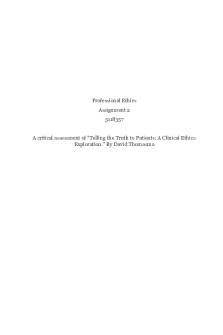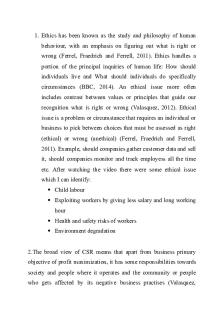PSY10003 Ethics Assignment PDF

| Title | PSY10003 Ethics Assignment |
|---|---|
| Author | Anush Mohan |
| Course | Introduction to Psychology 1 |
| Institution | Swinburne University of Technology |
| Pages | 5 |
| File Size | 145.6 KB |
| File Type | |
| Total Downloads | 70 |
| Total Views | 142 |
Summary
Ethics Assignment for PSY10003...
Description
Research Ethics Assignment
Anush Chandra Mohan Student Name (Number): 4915267 Due Date: 31st May 2019 Study Period: Semester 1 2019 Unit: PSY10003 Tutor: Ali Kodsi
"I declare that in submitting all work for this assessment I have read, understood and agree to the content and expectations of the assessment declaration."
Research Experience Program summary table Title
Length (mins)
Location
Report
1
Within-person variability in facial first impressions
30
Lab Based
Y
2
Relationship between visual imagery, perception, and visual processing Part 1
30
Online
N
3
Relationship between visual imagery, perception, and visual processing Part 2
60
Lab Based
Y
4
Judgements
30
Lab
Y
5
Spirituality, Naturalism, Mysticism, and Agnosticism in Personality The relationship between childhood environment, selfconcept and emotions
60
Online
N
30
Online
N
6
Study 1 Title: Judgments Ethical Value and Principle: Justice Report:
A social/behavioral research that consisted of a short mock crime video with the perpetrator wearing a disguise was displayed on a computer screen. A questionnaire was then presented along with different faces that looked similar to that of the original perpetrator from the mock crime video and the confidence level in regards to which of the multiple faces that was displayed in front of us on a computer screen closely resembled to that of the perpetrator was tested on a scale of 0-10. (1.4b, e) The recruitment process was online sign up. The Research clearly stated eligible participants. 18 years of age to 55 years of age. No Gender Discrimination was present. As a participant, a lab space with a computer, mouse keyboard and a set of headphones were presented to help with the participation in the study. Results to the study are accessible at the end of the research in one years’ time by contacting the principal investigator and details were provided. (1.4f)
Study 2 Title: Relationship between visual imagery, perception, and visual processing Part 2 Ethical Value and Principle: Respect Report:
1.12 The aim of this study is to better understand the nature of visual processing differences in mental imagery, and across the autism spectrum (Debriefing statement from Research). Diamond shapes on a moving on a fixed path on a computer screen was displayed with the shapes either moving diagonally or vertically depending on the focus of the eyes and the participants were requested the select a point at which the diamonds changed movement perspectival to the focus of the eyes on the screen with a movable red dot and then recorded the movement of the red dot from the edge of the screens to the inside of the screen. Due Respect was given by enabling the participants to choose the interval between slides to help make decisions which did not change the variables of the research. 1.11 The primary
investigator was respectful and sensitive to the questions of the participant and accommodating to any requests within the boundaries of the research variables.
Study 3 Title: Within-person variability in facial first impressions Ethical Value and Principle: Beneficence Report:
The purpose of this study is to develop a database of face images and subsequently have them rated in terms of perceived social traits (trustworthiness, dominance, attractiveness) (Debriefing statement from Research). The research was rating a series of face images of different identities with multiple photos per identity on a given social trait. The aim was to explore how first impressions vary across different photos of the same individual. (1.6) These impressions can have powerful influence over many important social outcomes as to how we perceive that individual without initially interacting with them. Therefore, understanding how faces are evaluated is of importance to the researcher and their study. (1.7b) The researcher pointed out risks of potentially recognizing some of the identities and if the participants are prone to flashing images and photosensitive epilepsy were advised to not participate. But the images were stable and had due interval between photos that did not trigger any strain to the eyes or any discomfort. (1.8) The benefits of the research for the participant included how first impression mattered and how we rated people on a social scale.
Study 4 Title: Judgements Ethical Value and Principle: Research merit and integrity Report:
As summarized earlier in study 1 about this research on its Value of Justice, its research merit and integrity shall be discussed in study 4 and is as follows. (1.3a, b, c) research is conducted with a team of 10 researchers seeking to find answers in accuracy of identifying
a perpetrator from a line up wearing a disguise and the degree of accuracy to which we can identify the target. (1.1 a, d, e)Justifiable by its potential merit by helping understand how participants perceived people wearing varying types of disguise and how their perceptions of disguise influenced their beliefs about the strength of their memory for the person presented in the video and the willingness to make an identification from a lineup. This research will help understand how accurate and helpful criminal line ups maybe in apprehending potential perpetrators in investigations. And if the information provided by the witness can count as evidence at trial. (1.2) This research was started on basis that previous researched indicated leading cause of wrongful conviction is mistaken eyewitnesses’ identifications. (Debriefing Summary from researchers have been used to help summarize these studies)...
Similar Free PDFs

PSY10003 Ethics Assignment
- 5 Pages

Ethics Assignment 2
- 6 Pages

Professional Ethics Assignment 2
- 8 Pages

Corina assignment - business ethics
- 26 Pages

Assignment 1 ethics essay
- 12 Pages

Ethics Assignment Essay
- 2 Pages

PSY3041 Ethics Assignment
- 7 Pages

Ethics assignment 2
- 5 Pages

Values and Ethics Assignment
- 13 Pages

Business ethics. Assignment 2
- 11 Pages
Popular Institutions
- Tinajero National High School - Annex
- Politeknik Caltex Riau
- Yokohama City University
- SGT University
- University of Al-Qadisiyah
- Divine Word College of Vigan
- Techniek College Rotterdam
- Universidade de Santiago
- Universiti Teknologi MARA Cawangan Johor Kampus Pasir Gudang
- Poltekkes Kemenkes Yogyakarta
- Baguio City National High School
- Colegio san marcos
- preparatoria uno
- Centro de Bachillerato Tecnológico Industrial y de Servicios No. 107
- Dalian Maritime University
- Quang Trung Secondary School
- Colegio Tecnológico en Informática
- Corporación Regional de Educación Superior
- Grupo CEDVA
- Dar Al Uloom University
- Centro de Estudios Preuniversitarios de la Universidad Nacional de Ingeniería
- 上智大学
- Aakash International School, Nuna Majara
- San Felipe Neri Catholic School
- Kang Chiao International School - New Taipei City
- Misamis Occidental National High School
- Institución Educativa Escuela Normal Juan Ladrilleros
- Kolehiyo ng Pantukan
- Batanes State College
- Instituto Continental
- Sekolah Menengah Kejuruan Kesehatan Kaltara (Tarakan)
- Colegio de La Inmaculada Concepcion - Cebu





